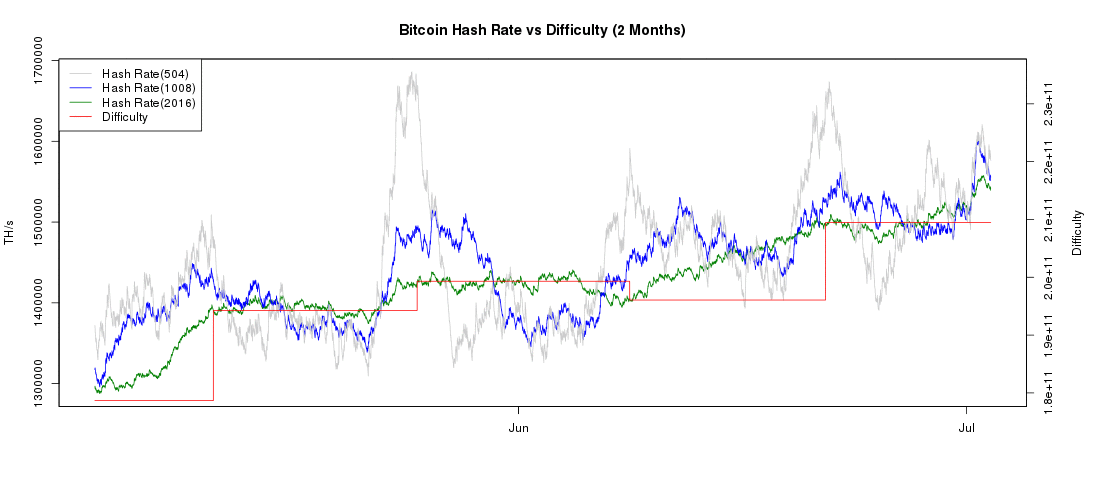As the graph below from BitcoinWisdom shows for the first time since just before ASICs (Application Specific Integrated Circuits) started to work on the bitcoin network it is possible that we may see a decrease in the difficulty of the bitcoin network. (This just in, it is official, the difficulty decreased to 40,007,470,271 a change of just under a percent. It may take some time for your client to adjust and the number to stabilise)
If you click on the graph and go to BitcoinWisdom the telling like is the green one, it is the actual hashrate of the bitcoin network derived from the average time that it takes to solve a block. You will see that it is below the actual difficulty represented by the red line.
At present the average time over the past two weeks (or 2016 blocks) is just over 10 minutes meaning that the bitcoin network will soon adjust itself down from the current 40,300,030,328 to an estimated 40,050,115,135, that is a decrease of about -0.62%.
For a good and more in depth of how the difficulty works and how these adjustments are made you may wish to check out the difficulty page on the bitcoin wiki.
Has this happened before?
Yes, many times (I have include a table below highlighting decreases for reference). Rest assured that this is not the end of bitcoin and is, at least technically, a normal function of the network. In fact it uses the exact same tried and proven mechanism that has seen the difficulty increase for the past 20 months or so.
| Date | Difficulty | Change | Hashrate |
| Dec 26 2012 | 2,979,637 | -11.59% | 21,329 GH/s |
| Dec 10 2012 | 3,370,182 | -2.00% | 24,125 GH/s |
| Jun 07 2012 | 1,583,178 | -0.50% | 11,333 GH/s |
| May 24 2012 | 1,591,075 | -8.20% | 11,389 GH/s |
| Apr 27 2012 | 1,508,590 | -4.39% | 10,799 GH/s |
| Apr 12 2012 | 1,577,913 | -2.99% | 11,295 GH/s |
| Feb 18 2012 | 1,376,302 | -0.24% | 9,852 GH/s |
The first difficulty decreases happened in 2011 when CPU mining was still practical and massive botnets were using unsuspecting people computers to mine bitcoins. As these botnets were discovered and taken down by security experts the difficulty took minor hits. As the total network hashrate back then was measured in KiloHashs per seconds (1000's of hashes per second) compared to todays TerraHashs Per Second (1,000,000,000,000's of hashes per second) even a tiny change was felt quite dramatically.
The second set of decreases was due to economics and the imminent arrival of ASIC's. At the time the bitcoin price was measured in dollars (single dollars, not hundreds as they are now) and mining was done with video cards and specialised mining software allowing miners clock their cards up to a typical speeds of about 100 MegaHash per second (A MegaHash is 1,000,000 hashes per second). At the time of the last difficulty decrease on January 23rd 2013 when the difficulty drop to 2,968,775 (a -8.64% decrease) the total bitcoin network was only 21,251 GH/s (or 21,251,000 hashes per second).
Back then, the price of bitcoins no longer justified the electricity it took to run your GPU mining rigs.
Why is the difficulty decreasing now?
Their are many reasons for the difficulty to decrease apart from the obvious statement that there is less hashpower being pointed at the bitcoin network. It is unlikely that the ASIC bitcoin miner manufacturers are voluntarily scaling back production, it is also unlikely that miners are voluntarily turning off their rigs for no reason.
There is a few possible reasons that the difficulty may decrease, but in the end there only one rational reason, economics.
Evidence seems to suggest that even the biggest hashing farms, with the cheapest electricity have reached the point where at the current price of bitcoin cannot justify adding new hashrate to the network.
Where do we go from here?
There are a few possible 'next steps' from here;-
- The bitcoin price will increase allowing the current generation of mining equipment to generate more bitcoins for their electricity consumption.
- The "Next Generation" of bitcoin miners using more electrically efficient ASIC's will boost us into another period of expansion.
Where it goes exactly is hard to tell, but it will be an interesting phase in the continued development of the bitcoin network.
Are we still safe?
With the network entering a possible stage of stagnation as far as mining hashrate is concerned you may ask yourself if the network can maintain it's safety, after all, securing the network is the main function of all this hashpower.
Rest assured though, even at the current status quo it would take hundreds of millions of dollars and many months of time to threaten the network. I plan to do a series of articles over the next few weeks to explore the possibilities and potential ramifications of the difficulty change that will be happening in less than an hour.

Comments
comments powered by Disqus